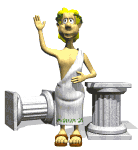

 You are a servant who has been hired to
educate little Cornelius. The pater familias has directed you to
teach him what is required of one who wants to become a consul. You
are very frightened because you know nothing about politics. How can
you teach him these things? If you don't, the master will beat you.
Then you decide that you will ask two of your friends who owe you a
favor to help you. Yes, that's it!
You are a servant who has been hired to
educate little Cornelius. The pater familias has directed you to
teach him what is required of one who wants to become a consul. You
are very frightened because you know nothing about politics. How can
you teach him these things? If you don't, the master will beat you.
Then you decide that you will ask two of your friends who owe you a
favor to help you. Yes, that's it!
First, give yourself and your friends Roman names. Together you will make a librum containing all the information Cornelius will need to know to become a consul one day. It will have three major parts.
Use these helpful links:
Patricians et Plebeians - This is an excellent site that describes the Patricians and Plebians. It tells why the Plebeians revolted and what they forced the Senate to do. Find out.
Social Classes -This site describes the different social classes, the Populares and Optimates, and how to campaign.
The Cursus Honorum - An excellent site that shows a diagram of the ladder of political advancement. It tells about the Cursus Honorum, the Sella Curulis, the many different magistrates with their descriptions, and the various assemblies.
The Assemblies and the Senate - This site tells how many members make up the Senate and its history as well as a description of the assemblies.
Assemblies from 218-49 b.c. - This site gives a chart of valuable information about their organization, presiding officer, meeting place and other interesting facts.
List of all the Consuls - This site gives the names of all of Rome's consuls and their dates of ruling. From the list, was a man ever elected more than once? Look for Gaius Julius Caesar and find out the years he was consul and who shared the consulship with him.
Description of the Offices - Here you will find a description of the offices of the Cursus Honorum and the special offices. It has an excellent chart of the offices which describes the functions of each office, length of terms, and much more. There is also information about the different assemblies and their functions.
More on the Offices - The Romans never had a written constitution, but their form of their government, (especially from the time of the passage of the lex Hortensia 287 B.C.), roughly parallels the modern American division of executive, legislative, and judical branches, although the senate doesn't neatly fit any of these categories. This site compares the Roman Republican Constitution to the Executive Branch (magistrates), the Legislative Branch (the assemblies), and the Sentate.
Evaluation
Your performance will be evaluated both individually and as a team. Therefore, it is very important that you work together. The following chart will explain your evaluation.
|
|
Beginning 1 |
Developing 2 |
Accomplished 3 |
Score |
|---|---|---|---|---|
|
|
|
|
Identified et explained five classes of people. Explained the Populares et Optimates. Explained how to campaign for office. No misspelled words et no grammatical errors. |
|
|
|
|
|
|
|
|
|
|
|
|
|
|
|
|
|
|
|
Conclusion
Your master is pleased with the liber you have prepared for little Cornelius. Now you too know more about the politics of Rome. The master has challenged you to do further study to learn the legacy of Roman government and law. See what else you can learn.
Thanks to VRoma.org and to the sites of Barbara McManus for most of these pictures and links.
The animated gif is from the animfactory.com website.